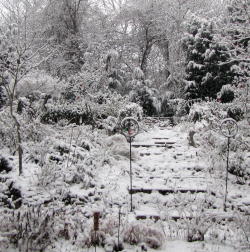
Every day of every month is a good time to think about the wildflowers, the natives and self sown immigrants that make the garden robust and diverse. The fourth Wednesday of each month has been designated as Wildflower Wednesday by my dear friend and fellow world traveler Gail of Clay And Limestone. Do feel free to join in the fun by poking about your own garden or out in the wild to see what can be seen, even as the plants fade to khaki colored carcasses.
Still lovely for a couple more months is the Pink Muhly sonogram, Muhlenbergia capillaris. The lower light rising in the Eastern sky illuminates the morning dew held by the inflorescens, creating an image that reminds one of an ultrasound, showing a baby in a human belly, in pink. It must be a girl!

Most of the wildling goldenrods, Solidago ssp. have been pulled or cut to prevent total takeover by the scattered seeds, but late blooming and still attracting pollinators happy yellows must be allowed to live a bit longer. The wild white asters add to the festive scene.

It is the late to the party crowd that appears in November. Somehow they misplaced the invitation, but we are glad to see they decided to grace us with post frost flowers. Echinacea tennesseensis ‘Rocky Top’ with the recurved petals is not all that happy here in the acid clay, minus the limestone it adores. All flowers are a bonus.

Rabbit Tobacco, Pseudognaphalium obtusifolium, sometimes shown without the Pseudo, which means false, is evidence that the taxonomists are at it again. It is also known as Pearly or Sweet Everlasting among other common names, and is sporadic here in the Fairegarden. We save and spread the seeds for more of a mass planting, but this annual continually pops up elsewhere, like in the middle of a gravel path. It will stand through the winter, offering silvery contrast to the evergreen shrubs. I just wish there was more of it! The American Painted Lady butterfly is said to favor it for egg laying, reason alone to have a field of it.

Plentiful and welcome is the wild ageratum, Conoclinium coelestinum, (honestly these names and the constant changing of them are getting on my last nerve!) and the colorful neighbor to the left. The ID of the rusty wildflower is unknown, but it has been allowed to colonize the slope of the middle terrace to the right of the concrete steps. Both are considered to be friends of the garden, already growing here when the human began interfering with the plantings.

The oxeye daisy, Leucanthemum vulgare, is another garden denizen grandfathered into the mix. It appears in every bed and blooms very nearly in every month. The evergreen rosette is easy to identify and can be moved safely in all seasons except summer to make for a mass planting. The yellow button mum is being quite chummy here, to everyone’s delight.

Just so you know, poison ivy wears fall colors that are not only shades of red. This bad boy is in dense shade under a Leyland Cypress and is bright yellow. It needs to be dealt with, sooner rather than later before the leaves are gone and it blends into the background.

A rampant self sower, the spiderwort, Tradescantia virginiana, has a blue flower that cannot be resisted. It is a color that zings straight to our heart, but since world domination is in its genes, most must be dug out. It is difficult to get the entire root system and it regrows quickly. Watch out for it, but man, what a color.
And now, do tell what wildflowers you have noticed this fine November?
Frances









Frances,
Our spiderwort seemed to die back from the summer drought. Now is is thriving but not blooming like your. Thanks for the words about goldenrod, it has been poking up everywhere around here this year, now I know to cut it back before seeding.
My wildflowers look more like Rose’s right now. Too many hard frosts. I like seeing your little blue ageratums. I need to get some of this started in our garden. I love the oxeye daisies too.
Oh, Your Muhly is so giving . . . I am trying to see the baby . . . maybe an ultrasound? Gorgeous photo. I love the late colors your wild ageratum, Echinacea and spiderwort offer. Lovely wildflower post. I am wishing you a Happy Thanksgiving Frances.
All my wildflowers have turned into khaki-colored carcasses, Frances, but they still have a certain appeal. Nothing to compare with your fantastic Muhly, though–it does look like a sonogram!
Hope your turkey has thawed and the pie dough is ready to roll out–wishing you and your family a very Happy Thanksgiving, Frances!
Nice to see blooms… my garden is sleeping under a frozen tundra today.
Happy Thanksgiving, Frances! I am thankful for your posts – always lovely to look at and educational as well.
I now know that the volunteer that I like so well, and am grateful that I didn’t weed out, is Rabbit Tobacco.
I always wondered what rabbit tobacco was – I read the name in Beatrix Potter’s books. I wonder why it’s called that?
Hi Frances, Your garden is still very colorful at this time of the year. Your wildflowers are beautiful.
Great idea! All our true wildflowers have finished here, tho.
I wish I would have success with coneflowers. What do they need that I have not provided for them? 🙂 Beautiful dark red poison oak is a major potion of our fall color here in the mountains near Yosemite.
We’re just about out of blooms outside here in Connecticut – so nice to see your remaining lovelies, esp. the muhly grass…
That first photo is spectacular. The lighting, The color. The feel and mood. I am so missing the fall beauty here. I am glad you still have so much to show. Happy Thanksgiving to you.
That first picture of the Pink Muhly is amazing it’s like something from a day dream, I spent a while just gazing at it and imagining the feeling.
That Muhly photo nearly makes me lightheaded.
I think your Hardy Ageratum’s mysterious neighbor is Acalypha virginica. I will not share any joy you have for this plant, as I spend much of my weeding time at work trying to eliminate it from the beds.